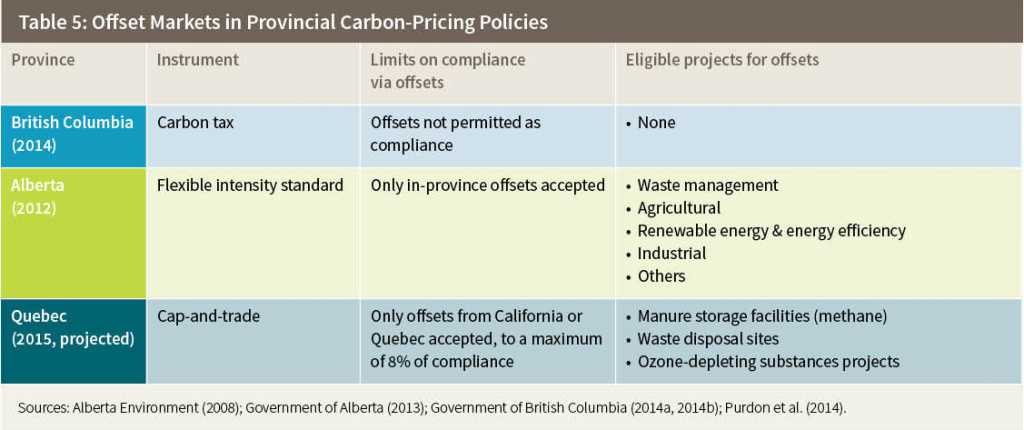
Four Things You Should Know about Carbon Offsets
Last week, Ontario and Quebec announced that they’d be collaborating on a carbon offset system as part of their respective cap-and-trade policies. What’s an offset, you ask? And what are the implications of this provincial tag-team, you wonder? As usual, the Ecofiscal blog has you covered.
1. What a Carbon Offset is and How it Works
As the name implies, a carbon offset lowers emissions in one part of the economy to make up for or “off set” increased emissions somewhere else.
It works something like this: A firm takes some action to reduce emissions in a way that is not covered directly by a basic carbon pricing policy. For example, a firm could capture methane emissions from a landfill that would otherwise have been added to the atmosphere. Projects like this can get “credits” for the emissions they reduce. And this credit can be bought and sold within the existing carbon market. So a company that is having a hard time reducing its own greenhouse gas levels can purchase a credit produced by one of these projects to “offset” its emissions.
2. Why Include Offsets in Carbon Pricing Policies
Offsets are a practical way of broadening coverage of a system, beyond the emissions that can be priced directly. In practice, some emissions are tricky to include under a carbon pricing policy. Methane emissions from landfills, for example, are powerful greenhouse gas emissions. But unlike emission from fuel combustion (which are generally a function of the type of fuel being burned), quantifying landfill methane emissions accurately is challenging.
Similarly, pricing emissions doesn’t create incentives for actions or projects that remove GHG emissions from the atmosphere—such as planting trees, or using alternative agricultural practices to sequester emissions in soil.
In the world of carbon pricing, broader is better. Creating incentives for a broader set of potential emissions reductions (for example through the kinds of project mentioned above) means that more low-cost emissions reductions are realized. It creates more flexibility for driving the lowest cost emissions reductions overall, and minimizing costs of policy, both for individual emitters and the system overall.
3. What it Takes to Get Carbon Offsets Right
Still, carbon offsets aren’t necessarily a no-brainer, and their reputation is definitely mixed. If implemented poorly, offsets risk undermining the integrity of a carbon pricing system.
So how do you get offset programs right? Two main questions matter.
Would the emission reduction have happened anyway, even if no policy existed? If the answer is “yes,” than the project should not count this as an offset and should not reward it with a credit. It’s sort of like paying your kids to do their homework: giving someone a financial incentive to do something they have to do, or are going to do, anyway is not a good use of money. British Columbia’s Auditor General identifies this problem in B.C.’s offset program, which was used to help government facilities achieve carbon neutrality.
Is the emission reduction permanent? If an offset is granted for planting trees, only to have those trees cut down later, fewer true emissions reductions are associated with the credits.
Strong and transparent governance of offsets can help address these concerns. Offsets in Alberta’s Specified Gas Emitters Regulation, for example, are verified by independent third parties; offset protocols pass through technical, stakeholder, and public reviews.
In response to these risks, carbon-pricing systems sometime limit the extent to which offsets can contribute to overall compliance with the policy. The table below, from our report The Way Forward, summarizes the role of offsets in existing carbon pricing systems in BC, Alberta, and Quebec.
4. Why Create a Common Offset Market
That brings us back to the recent announcement from Quebec and Ontario. Given the importance of strong governance, cooperating makes sense. Detailed protocols or methodologies for different types of offset projects are required to ensure that the emission reductions they represent are credible. And because making good protocols takes time, collaboration is efficient.
It also creates an early signal to offset projects in Ontario, even in advance of the carbon pricing policy being finalized. By indicating that Ontario’s offset system will work in parallel with Quebec’s existing system, developers of potential offset projects have some level of certainty as to what the rules of the game will be. And helps them to get moving.
Finally it also could also represent another subtle step toward coordination. The expectation is that Ontario and Quebec will link their cap-and-trade systems, allowing permit trade between emitters in Ontario, Quebec, and California. But a common offset market is another way to indirectly link different carbon pricing systems, even ones with very different policy designs.
Sooner or later, Canadian provinces will have to have serious conversation about coordinating sub-national carbon pricing policies. And common offset markets are one part of the coordination tool-kit.





6 comments
Thank you for this great blog entry!
Reading the G&M article, I was surprised to see that “projects can include everything from wind or solar farms to programs that produce more energy-efficient buildings (…)”. As the emitting energy sector will be covered (it has to be!), allowing renewable energy as offsets is a form of double counting as energy production would be displaced from within the cap to outside the cap. More over, if the Large Renewable Procurement (LRP) program or a replacing complementary policy incentivizing renewable development exists in parallel with the C&T, there would also be additionality issues as the reductions would have happened anyways.
I wonder if this line was actually mentioned by Ministers or if it was the journalist just guessing…
I’d like to hear your thoughts about this.
Cheers
F.
Great comment, Felix; thanks. I totally agree with you: offsets have to be from otherwise uncovered emissions to avoid double counting, and the G&M article seems to suggest otherwise. The official Quebec press release is pretty explicit, however, about offsets only coming from emissions outside of the cap. And all the Quebec offset protocols so far have fit that pattern.
Thanks again,
Dale
I wouldn’t be at all surprised if Ontario is planning allow for double counting on renewable generation. I suspect G&M already knows that. This prov.gov’t has a history of heavily incentivising chosen sectors regardless of cost/benefit. And it would work nicely for the large portion of Ontario’s RE sector that are primarliy fossil, like Enbridge TransAlta, Suncor that were in early.
Lets be honest in that On.’s R.E. shift is about alot of gas and a little RE replacing a significant portion of the public owned nuclear fleet.
The big question as far as real emissions reduction is whether our own nuclear will be fairly rewarded.
Hi Dale,
Thanks for this good overview of offsets.
It seems to me that the additionality is never as believable as very real carbon emission that are supposedly being offset.
You said: “Strong and transparent governance of offsets can help address these concerns. Offsets in Alberta’s Specified Gas Emitters Regulation, for example, are verified by independent third parties; offset protocols pass through technical, stakeholder, and public reviews.”
But despite all this, there have been serious concerns about Alberta’s offset quality. For example, this CTV news article about Alberta’s auditor general’s concerns: http://www.ctvnews.ca/alberta-not-properly-monitoring-carbon-offsets-auditor-1.730312#ixzz1fUGRIkma
I can see the short term political gain in allowing offsets – who doesn’t like to get money, sometimes just for doing something you were “almost” going to do anyway! But longer term, I think offsets and the constant drip of bad news stories about bogus offsets, can erode support for carbon pricing.
I say kudos to BC for saying no to offsets. Perhaps it is one of the reasons the BC carbon pricing system is increasingly politically popular.
-Greg
Nice overview. A few (hopefully) clarifications and developments:
I agree with Greg that Alberta offset system is not the greatest. Yes, they have third party verification, but the best practice is a double third party check with both ‘validation’ (of the project before it gets off ground to ensure sound engineering etc) AND ‘verification’ (after the fact to ensure that the offsets are real etc). Alberta just has the verification step and also has some other issues with their offset system.
At the same time, I do believe carbon offsets CAN work. Technically, if the money provided from offset sales can spur a carbon reduction that wouldn’t otherwise happen, and the benefits sold to an entity that cannot easily reduce, offsets can and do work. I’ve looked at the project docs from engineering fuel switch to forest offsets, and they can be very robust, and offsetting can also serve as a stimulus to raise the bar on clean tech over time.
Yes, additionality and things like leakage can be big issues that have plagued past markets, but many markets have evolved better standards because of these issues over the years as well. California (ARB), CDM and the VCS standards are among the highest and can and do provide charismatic, high quality offsets, many which also have environmental and social co-benefits. (CDM had some major issues, and forest offsets also did in their early days, but the rigour of the methodologies has really improved, and assurance for additionality is more robust now.) The Western Climate Initiative (which was supposed to take off to connect provincial and state systems, and may get a second wind if Canada gov changes leading to promised climate action federally) is also quite robust.
The article and the table is a titch misleading though about the use of carbon offsets in BC. In addition to the Carbon Tax in BC, there IS an offset market for the public sector at about $25/t CO2e. (Here is their call for carbon offset projects: http://www2.gov.bc.ca/gov/content/environment/climate-change/stakeholder-support/offset-project-development-opportunities and here is their overview page: http://www2.gov.bc.ca/gov/content/environment/climate-change/policy-legislation-programs/carbon-neutral-government/offset) So, the PCT was dissolved, but the BC government is still very involved in offsetting. Here are the list of reports of annual offsets retired up to the 2015 report: http://www2.gov.bc.ca/gov/content/environment/climate-change/reports-data/carbon-neutral-action-reports/carbon-offset-projects
In addition to offsets for the government carbon neutral aims for gov, carbon offsets have been tabled for what will likely (given current gov trajectory) be BC’s largest source of GHGs going forward, the natural gas industry. So, things are in flux in the regulatory sphere because of this (and because of issues with PCT before and fail of carbon market taking off with the feds reneging on Kyoto and the fed cap and trade bill falling through etc). The Greenhouse Gas Industrial Reporting and Control Act is likely to come into effect soon (replacing the previous GHG Reduction (Cap and Trade) Act, that never really got off the ground, and will cover LNG and coal fired electricity plants.
Per the tabled GHG Industrial Reporting and Control Act, use of carbon offset mechanism is slated to start with allowing LNG industry 3 compliance mechanisms if they don’t meet the 0.16 tCO2e/tLNG benchmark: 1. invest in a technology fund (rather like in Alberta), 2. use banked credits created from when a facility goes under their target, or 3. use carbon offsets. Unlike BC, it looks like the proposed Offset Regulation does include validation and verification, among other things. http://www.bclaws.ca/EPLibraries/bclaws_new/document/ID/freeside/393_2008
More info:
– Policy paper on the new Compliance Framework under Greenhouse Gas Industrial Reporting and Control Act: http://www2.gov.bc.ca/assets/gov/environment/climate-change/policy-legislation-and-responses/climate-action-legislation/ggirca_complianceintentionspaper.pdf
– Policy paper on Offsets Regulation under the Greenhouse Gas Industrial Reporting and Control Act: http://www2.gov.bc.ca/assets/gov/environment/climate-change/policy-legislation-and-responses/climate-action-legislation/ggirca_offsetsregintentionspaper.pdf
Cheers,
Maria
Belatedly: lots of good points made here. Thanks for the comments all!
Comments are closed.